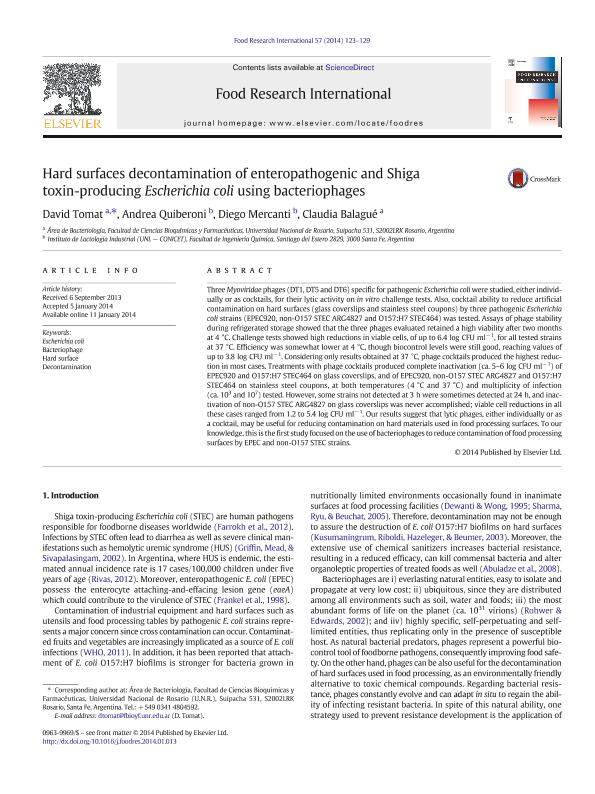Artículo
Hard Surfaces Decontamination of Enteropathogenic and Shiga Toxin-Producing Escherichia coli using Bacteriophages
Fecha de publicación:
03/2014
Editorial:
Elsevier
Revista:
Food Research International
ISSN:
0963-9969
Idioma:
Inglés
Tipo de recurso:
Artículo publicado
Clasificación temática:
Resumen
Three Myoviridae phages (DT1, DT5 and DT6) specific for pathogenic Escherichia coli were studied, either individually or as cocktails, for their lytic activity on in vitro challenge tests. Also, cocktail ability to reduce artificial contamination on hard surfaces (glass coverslips and stainless steel coupons) by three pathogenic Escherichia coli strains (EPEC920, non-O157 STEC ARG4827 and O157:H7 STEC464) was tested. Assays of phage stability during refrigerated storage showed that the three phages evaluated retained a high viability after two months at 4 °C. Challenge tests showed high reductions in viable cells, of up to 6.4 log CFU ml−1, for all tested strains at 37 °C. Efficiency was somewhat lower at 4 °C, though biocontrol levels were still good, reaching values of up to 3.8 log CFU ml−1. Considering only results obtained at 37 °C, phage cocktails produced the highest reduction in most cases. Treatments with phage cocktails produced complete inactivation (ca. 5?6 log CFU ml−1) of EPEC920 and O157:H7 STEC464 on glass coverslips, and of EPEC920, non-O157 STEC ARG4827 and O157:H7 STEC464 on stainless steel coupons, at both temperatures (4 °C and 37 °C) and multiplicity of infection (ca. 103 and 107) tested. However, some strains not detected at 3 h were sometimes detected at 24 h, and inactivation of non-O157 STEC ARG4827 on glass coverslips was never accomplished; viable cell reductions in all these cases ranged from 1.2 to 5.4 log CFU ml−1. Our results suggest that lytic phages, either individually or as a cocktail, may be useful for reducing contamination on hard materials used in food processing surfaces. To our knowledge, this is the first study focused on the use of bacteriophages to reduce contamination of food processing surfaces by EPEC and non-O157 STEC strains.
Palabras clave:
Escherichia Coli
,
Bacteriophage
,
Hard Surface
,
Decontamination
Archivos asociados
Licencia
Identificadores
Colecciones
Articulos(CCT - ROSARIO)
Articulos de CTRO.CIENTIFICO TECNOL.CONICET - ROSARIO
Articulos de CTRO.CIENTIFICO TECNOL.CONICET - ROSARIO
Articulos(INLAIN)
Articulos de INST.DE LACTOLOGIA INDUSTRIAL
Articulos de INST.DE LACTOLOGIA INDUSTRIAL
Citación
Tomat, David Damian; Quiberoni, Andrea del Lujan; Mercanti, Diego Javier; Balagué, Claudia; Hard Surfaces Decontamination of Enteropathogenic and Shiga Toxin-Producing Escherichia coli using Bacteriophages; Elsevier; Food Research International; 57; 3-2014; 123-129
Compartir
Altmétricas




